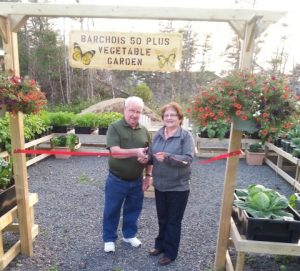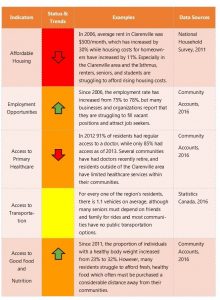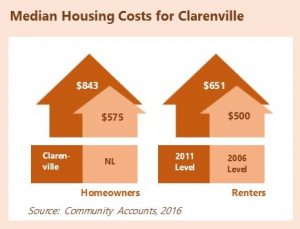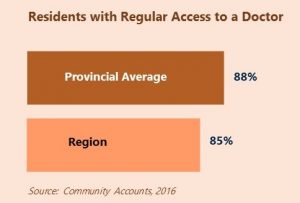Why is This Important?

The Come-by-Chance community garden was recently started by the Town of Come-by-Chance to help provide healthy food and engage seniors in the community. Photo credit: Roger Goobie.
A sustainable region must ensure a good quality of life for all residents. A public survey conducted in 2015, in which 299 residents of the region participated, identified that residents’ top concerns included things like employment, affordable housing, access to healthy and affordable food, and healthcare services. As economic growth transforms many communities, we must ensure that people benefit equitably and can meet their needs. We must also celebrate local initiatives that are improving access to healthy food, creating new jobs, and helping residents meet their basic needs locally.
Key Indicators and Trends
To measure the region’s progress towards this priority, the research team chose the indicators below and measured recent trends across the region that showed whether they are currently changing. Each of these indicators has a number of data points that allowed us to gauge how it is doing, some of which are shown below.

Based on both public data and community perspectives, we determined that affordable housing was the indicator most in need of improvement. This was based on rising housing costs in Clarenville, the only community in the region that Census data can be used to track measures such as average housing prices and how many  residents are spending more than 30% of their income on housing. Local residents in many other communities confirmed this trend, which some considered to be related to real estate growth in Clarenville and the Isthmus linked to Bull Arm and other industrial development.
residents are spending more than 30% of their income on housing. Local residents in many other communities confirmed this trend, which some considered to be related to real estate growth in Clarenville and the Isthmus linked to Bull Arm and other industrial development.

The graphic on the right shows the increase in housing prices in Clarenville for both homeowners and renters between 2006-2011, the last year that Census data are available. This rapid rise in housing costs, combined with a large amount of people spending more than 30% of their income on housing (the limit for what is considered “affordable housing”), contributed to the indicator’s rating as “poor”.

Another area of concern for the region is access to healthcare. The graph on the left shows that fewer residents have regular access to a doctor than the NL average. Also, residents in many communities must travel long distances to see a doctor or receive specialized services. Several doctors in the region have also recently retired. We ranked this indicator as “moderate”, but following a downward trend in recent years.
Overall Status: Moderate
Our assessment of each of the indicators in this area showed that the region overall has a considerable way to go to ensure that all residents can meet their basic needs. The challenges in healthcare and housing discussed above, as well as other disturbing trends in other indicators, contributed to this ranking. However, we must support organizations that are working hard to help improve access to services and amenities in communities, like community gardens that are providing healthy and fresh food, new businesses that are creating jobs for local residents, and initiatives like the CREST bus that are providing public transportation for seniors in Clarenville and nearby communities.
